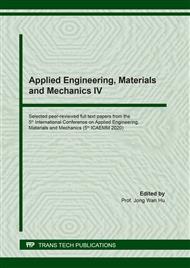[1]
I. Adam, R. Taha, Identifying the significance of factors affecting creep: a probabilistic analysis of RILEM database, Int. J. Concr. Struct. Mater. 5(2) (2011) 97-111.
DOI: 10.4334/ijcsm.2011.5.2.97
Google Scholar
[2]
L. Yanying, Z. Yongsheng, An analysis of temperature stress and deforming considering shrinkage and creep in super-long frame structure, Key Eng. Mater. 326-328 (2006) 1467-1470.
DOI: 10.4028/www.scientific.net/kem.326-328.1467
Google Scholar
[3]
ACI Committee 209-Creep and volume changes in concrete, Prediction of creep, shrinkage, and temperature effects in concrete structures, American Concrete Institute.
DOI: 10.14359/1256
Google Scholar
[4]
Z. P. Bazant, S. Baweja, Creep and shrinkage prediction model for analysis and design of concrete structures: Model B3, ACI Special Publications, (2000) 1-84.
Google Scholar
[5]
F. I. Du Beton, Structural concrete. Textbook on behavior, design and performance-updated knowledge of the CEB/FIP model code 1999, vol 1-3, Federation Internationale du Beton (FIB), Lausanne, Switzerland, (1990).
DOI: 10.35789/fib.bull.0003
Google Scholar
[6]
N.J. Gardner, Design provisions for shrinkage and creep of concrete, In Adam Neville Symposium: Creep and Shrinkage-Structural Design Effects, American Concrete Institue, (2000).
DOI: 10.14359/9891
Google Scholar
[7]
H. Cagnon, T. Vidal, A. Sellier, J. M. Torrenti, Transient thermal creep at moderate temperature, Key Eng. Mater. 711 (2016) 885-891.
DOI: 10.4028/www.scientific.net/kem.711.885
Google Scholar
[8]
J. S. Mun, K. H. Yang, S. J. Kim, Long-term behavior of low-heat cement concrete under different curing temperatures, Key Eng. Mater. 723 (2017) 819-823.
DOI: 10.4028/www.scientific.net/kem.723.819
Google Scholar
[9]
K. Tvrda, J. Drienovska, Analysis of creep effects in a concrete beam using various software, Key Eng. Mater. 738 (2017) 79-88.
DOI: 10.4028/www.scientific.net/kem.738.79
Google Scholar
[10]
P. Wang, F. H. Wittmann, W. Lu, T. Zhao, Influence of sustained load on durability and service life of reinforced concrete structures, Key Eng. Mater. 711 (2016) 638-644.
DOI: 10.4028/www.scientific.net/kem.711.638
Google Scholar
[11]
W. Lin, J. LIU, Influence of reinforcement placement on the creep of concrete, Key. Eng. Mater. 629-630 (2015) 130-135.
DOI: 10.4028/www.scientific.net/kem.629-630.130
Google Scholar
[12]
J. Xiao, H. Li, The state-of-the-art on long-term property of recycled aggregate concrete, Key Eng. Mater. 517 (2012) 522-527.
DOI: 10.4028/www.scientific.net/kem.517.522
Google Scholar
[13]
M. Mazloom, A. A. Ramezanianpour, J. J. Brooks, Effect of silica fume on mechanical properties of high-strength concrete, Cement Concrete Comp. 26(4) (2004) 347-357.
DOI: 10.1016/s0958-9465(03)00017-9
Google Scholar
[14]
S. S. Kristiawan, A. P. Nugroho, Creep behaviour of self-compacting concrete incorporating high volume fly ash and its effect on the long-term deflection of reinforced concrete beam, Procedia Eng. 171 (2017) 715-724.
DOI: 10.1016/j.proeng.2017.01.416
Google Scholar
[15]
D. G. Herr, On the history of ANOVA in unbalanced, factorial designs: The first 30 years, The American Statistician, 40(4) (1986) 265-270.
DOI: 10.1080/00031305.1986.10475409
Google Scholar
[16]
O. Langsrud, ANOVA for unbalanced data: use Type II instead of Type III sums of squares, Statistics and Computing, 13(2) (2003) 163-167.
Google Scholar
[17]
X. Wang, Y. Zhang, Y. Tang, Feasible criterion for designs based on fixed effect ANOVA model, Stat. Probabil. Lett. 87 (2014) 134-142.
DOI: 10.1016/j.spl.2014.01.020
Google Scholar
[18]
W. Cui, J. Huang, H. Song, M. Xiao, Development of two new anti-washout grouting materials using multi-way ANOVA in conjunction with grey relational analysis, Constr. Build. Mater. 156 (2017) 184-198.
DOI: 10.1016/j.conbuildmat.2017.08.126
Google Scholar


